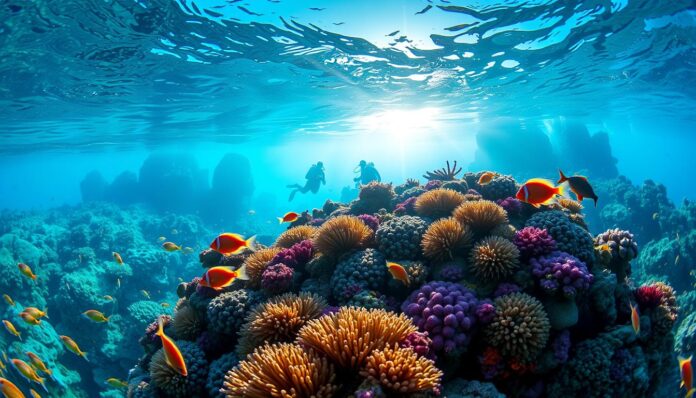| Best Time to Travel | Mid-July to early September |
| What to Expect | Warm water, clear visibility, diverse marine life |
| Diving Conditions | Year-round, but best from July to September |
| Marine Life | Whale sharks, manta rays, turtles, sharks, dolphins, fish |
Have you ever wondered where the most extraordinary underwater adventures await in a country composed of 6,000 islands? Scuba diving in Japan promises an unparalleled journey through diverse marine landscapes that challenge every diver’s imagination.
Japan offers a remarkable underwater exploration experience that spans from tropical southern waters to the icy northern seas. With over 70% of its landscape covered by volcanic mountains, the country’s unique geography translates into extraordinary diving conditions that attract underwater enthusiasts worldwide.
Underwater exploration in Japan isn’t just a sport—it’s a gateway to discovering marine ecosystems that range from vibrant coral reefs to mysterious shipwrecks. Whether you’re a novice or an experienced diver, Japan’s waters hold incredible secrets waiting to be uncovered.
Key Takeaways – Scuba Diving in Japan
- Japan offers diverse diving experiences across 6,000 islands
- Diving opportunities range from tropical to ice diving environments
- Non-certified divers can explore depths up to 6 meters
- Peak scuba diving season runs from mid-July to mid-September
- Diving costs vary from INR 4,000 to INR 13,000 depending on location
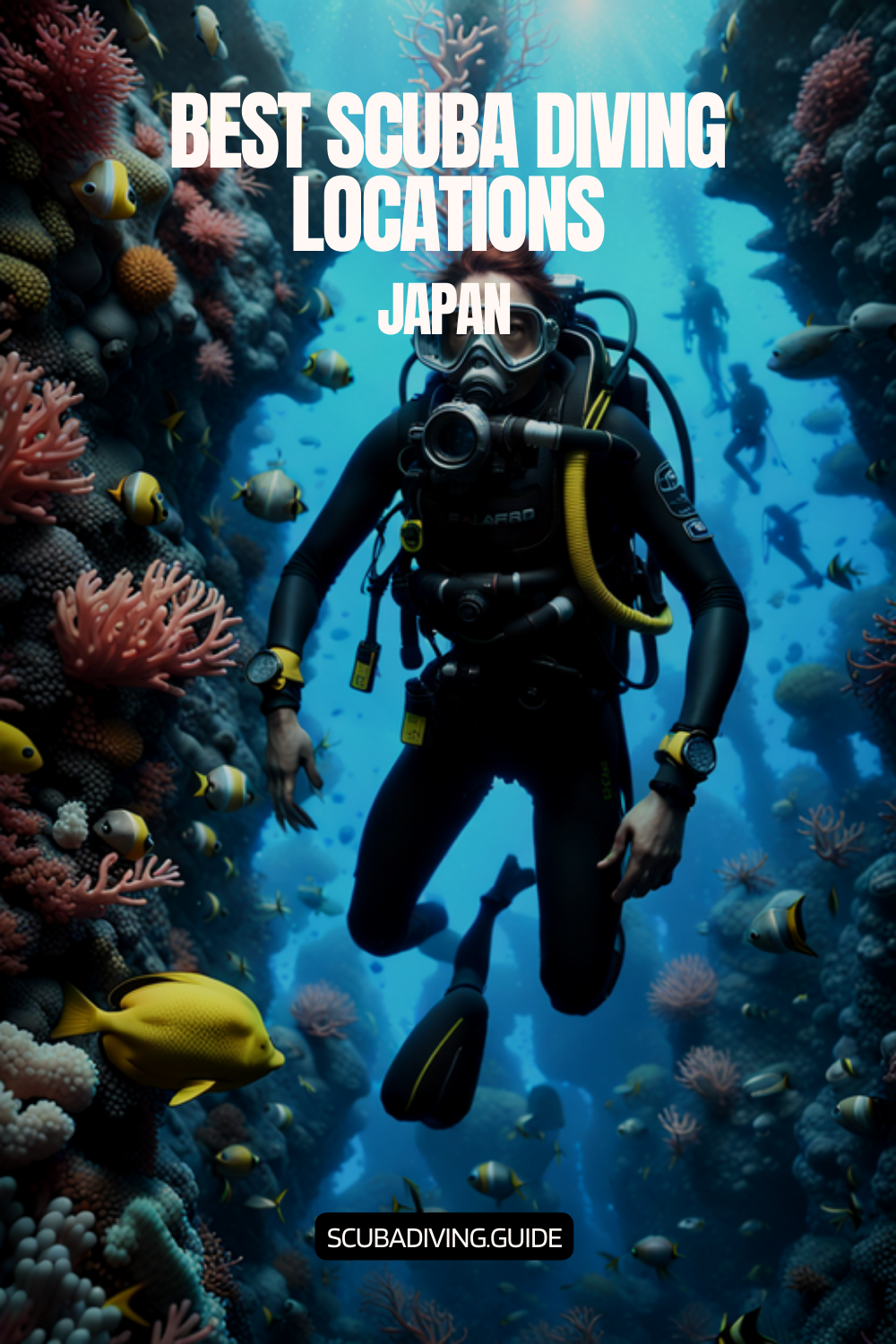
Overview of Scuba Diving in Japan
Japan’s underwater world is unlike any other place. Its unique location makes it a top spot for divers. With over 7,000 islands and 34,000 km of coastline, Japan’s dive sites are unmatched.
The variety of marine life in Japan is amazing. From tropical reefs to kelp forests, each area has its own wonders. Divers can see many different species in each place.
Unique Marine Biodiversity
Japan’s seas are full of life. The country’s dive spots show a wide range of marine life:
- Tropical waters around Okinawa with year-round diving conditions
- Cold-water habitats in Hokkaido with unique marine species
- Temperate zones featuring diverse marine populations
“Japan’s underwater world is a living museum of marine biodiversity, showing divers the beauty of aquatic ecosystems.”
Cultural Significance
Diving in Japan is more than just fun. It’s tied to the country’s culture, like the Ama divers. These traditional female pearl divers have been diving for centuries.
| Region | Key Marine Life | Unique Characteristics |
|---|---|---|
| Okinawa | Tropical Fish, Manta Rays | Warm waters, Year-round diving |
| Hokkaido | Pacific Octopus, Drift Ice Marine Life | Winter ice diving opportunities |
| Kerama Islands | Yellow Boxfish, Damselfish | Diverse marine ecosystem |
With over 2,000 dive spots, Japan has a wide range of underwater adventures. These experiences mix natural beauty with cultural heritage.
Best Locations for Scuba Diving
Japan is a paradise for scuba diving, with its 6,852 islands and diverse marine life. From tropical waters to cold-water ecosystems, it offers a unique diving experience. This makes Japan a top choice for diving enthusiasts worldwide.
Okinawa Diving is a highlight of Japan’s underwater world. It has warm waters all year and a rich variety of marine life. Ishigaki Island Diving is known for its stunning underwater landscapes.
- Tropical Diving Hotspots: Okinawa Islands
- Cold Water Diving: Hokkaido’s Unique Locations
- Historical Dive Sites: USS Emmons Wreck
- Marine Diversity: Suruga Bay
Japan’s diving spots each have their own charm. Divers can see manta rays at Ishigaki Island’s Manta Scramble. The clear waters of Lake Shikotsu offer a different underwater adventure.
“Japan’s underwater world is a hidden treasure waiting to be explored by passionate divers.” – Marine Exploration Magazine
Some of the best diving areas include:
- Okinawa Archipelago
- Izu Peninsula
- Ogasawara Islands
- Hokkaido Coast
Japan welcomes both new and experienced divers. It has top-notch diving spots and PADI certification centers in major cities and diving areas.
Okinawa: The Tropical Paradise
Dive into Okinawa, Japan’s southernmost prefecture, for an extraordinary diving experience. This tropical paradise has crystal-clear waters and vibrant marine ecosystems. It offers diving opportunities all year round, attracting divers from around the world.
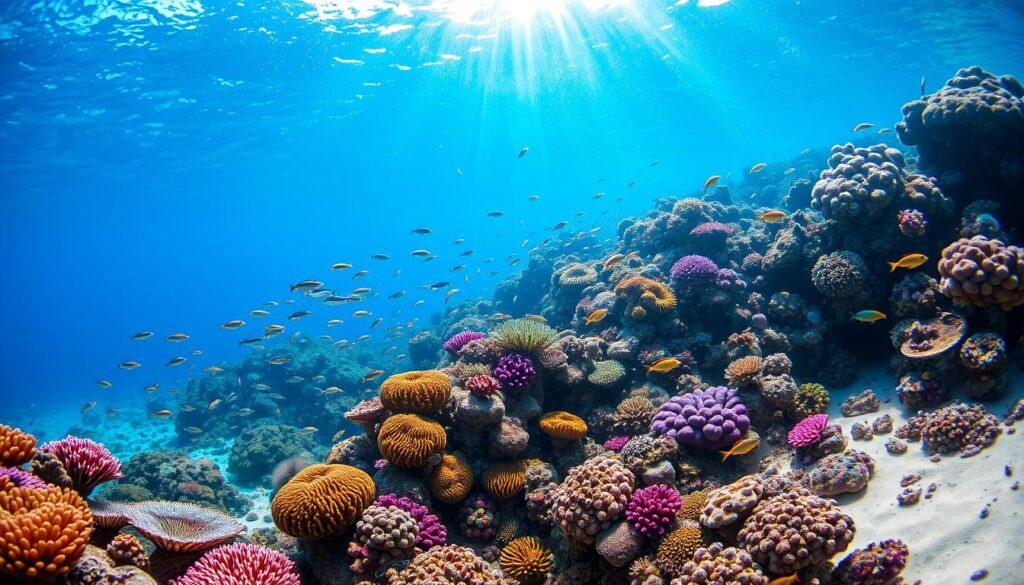
Okinawa’s marine biodiversity is remarkable. It’s home to about 200 of the world’s 800 coral species. This makes it a great place for snorkeling in Japan’s most beautiful marine environments.
Spectacular Dive Sites
Okinawa has many world-class diving locations for all levels. Some top sites include:
- Manta Scramble: Famous for manta ray sightings from April to November
- Kerama Islands: Featuring over 100 dive points and 200 coral types
- Ishigaki Island: Part of Iriomote-Ishigaki National Park
- Kumejima: Home to a year-round manta cleaning station
Marine Life and Coral Reefs
Okinawa’s underwater world is full of marine biodiversity. The water temperature is perfect for many marine species, ranging from 21.5 to 28.6 degrees Celsius.
| Diving Conditions | Details |
|---|---|
| Average Water Temperature | 21.5 – 28.6°C |
| Summer Land Temperature | Around 30°C |
| Diving Costs | 11,000 – 20,000 yen for 2-3 boat dives |
“Okinawa’s underwater world is a living canvas of color, movement, and breathtaking marine life.” – Local Diving Expert
Okinawa is perfect for diving or snorkeling. It offers an unforgettable underwater adventure. You’ll make memories that will last a lifetime.
The Rich Waters of Miyakojima
Miyakojima is 300 km south of Okinawa Main Island. It’s a top spot for diving in Japan. The “Miyako Blue” waters are famous for their clearness and stunning marine views.
Dive resorts in Japan don’t get much better than Miyakojima. The island has unique underwater features like limestone caves and coral reefs.
Notable Dive Spots
- Antonio Gaudi Dive Point: A challenging site with a depth of 35 meters, requiring advanced diving certification
- Tori Pond: A fascinating 75-meter diameter underwater location featuring a connecting cave system
- Devil’s Palace: Recommended diving season from November to April
- Irabu Shipwreck: A calm dive site with a maximum depth of 18 meters
Seasonal Highlights
| Season | Temperature | Diving Conditions |
|---|---|---|
| Summer (April-October) | 30°C+ | Warm, active marine life |
| Winter (January-February) | 18°C | Calmer waters, excellent visibility |
“Miyakojima represents the pinnacle of underwater exploration in Japanese dive sites” – Marine Exploration Magazine
Miyakojima has over 25 km of coral reefs. Visibility here often goes over 40 meters. It’s a top choice for those looking for adventure in Dive Resorts Japan.
Overview of the Izu Peninsula
The Izu Peninsula is just a few hours from Tokyo. It’s a top spot for Underwater Exploration Japan. This mountainous area meets the Pacific Ocean, giving divers a unique place to dive.
For those looking for PADI Certification Japan, the Izu Peninsula is perfect. It has famous dive sites and great marine conditions. This makes it great for both new and seasoned divers.
Diving Conditions
The Izu Peninsula has great diving all year. Water temperatures are:
- Summer months (July-September): Around 24°C
- Winter months (December-April): Approximately 15°C
Wetsuit thickness changes with the seasons:
- Summer diving: 5 mm wetsuit
- Winter diving: 7 mm wetsuit or drysuit
Famous Dive Sites
The peninsula has many amazing dive spots. Each one is special in its own way:
- Osezaki: Dive depths range from 15 to 60 meters
- Izu Ocean Park: Depths are between 10 to 40 meters
- Atami: Dive depths are from 20 to 40 meters, with an 81-meter shipwreck
- Koganezaki: Shore dives up to 21 meters
- Hatsushima: Shore dives reach 23 meters
“The Izu Peninsula transforms underwater exploration into an unforgettable journey through Japan’s marine wonderland.” – Local Diving Expert
Getting to the Izu Peninsula is easy. A 45-minute Shinkansen ride from Tokyo to Atami makes it a great spot for scuba diving.
The UNESCO World Heritage: Ogasawara Islands
The Ogasawara Islands are about 1,000 km south of Tokyo. They are a stunning marine sanctuary recognized by UNESCO for their amazing biodiversity. Known as the “Galapagos of the East,” these islands offer scuba divers a unique chance to explore Japan’s best dive sites.
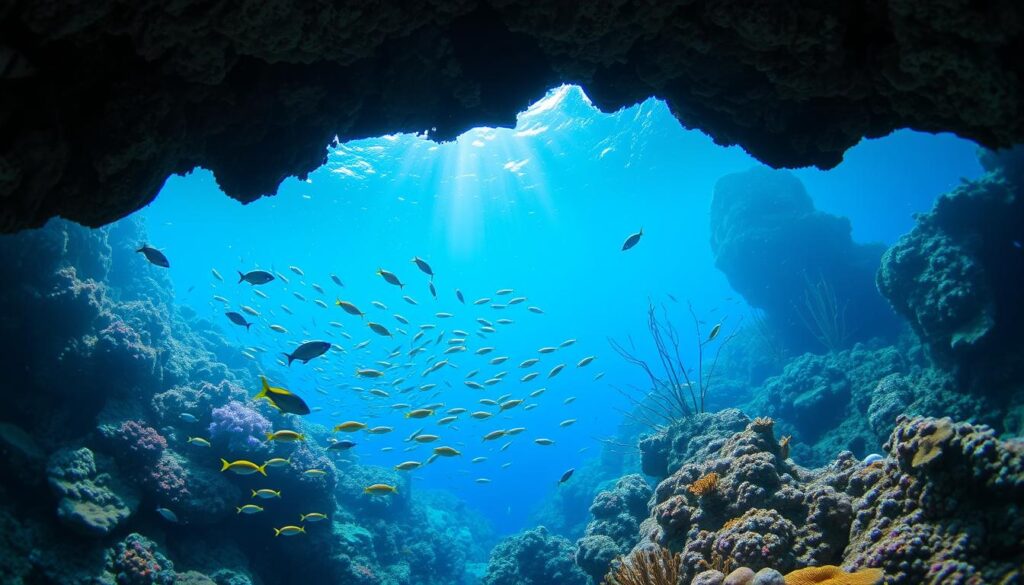
This archipelago has incredible marine environments that draw divers from all over. Divers can see the Bonin Blue ocean, a color found only here.
Marine Diversity Highlights
The Ogasawara Islands have an underwater world full of unique species. Visitors can see amazing marine creatures like:
- Wrought-iron butterflyfish swimming in large groups
- Humpback whales averaging 14 meters in length
- Rare pelagic species found nowhere else on Earth
Dive Tour Options
Many dive operators offer tours to explore the islands’ marine ecosystems. Summer is the best time for diving, with calm seas and perfect conditions.
“The Ogasawara Islands represent a pristine underwater world waiting to be discovered.” – Marine Exploration Magazine
Scuba enthusiasts can pick from various tour packages. These tours are designed for all skill levels, making for an unforgettable marine adventure.
Exploring the Japanese Sea: Noto Peninsula
The Noto Peninsula is a top spot for underwater exploration in Japan. It offers divers a chance to see unique marine landscapes in the Sea of Japan. This area stretches about 100 kilometers into the sea, making it a standout destination.
Underwater exploration in Japan has a special spot in the Noto Peninsula. Here, divers can see an ecosystem unlike any other in the country.
Distinctive Dive Site Features
The dive sites in the Noto Peninsula are known for their unique features. Divers will find:
- Rocky underwater terrain
- Diverse marine habitats
- Seasonal marine life variations
- Relatively untouched underwater landscapes
Marine Habitat Diversity
The marine ecosystem of the Noto Peninsula is incredibly diverse. Local waters are home to many marine species adapted to the Sea of Japan’s conditions.
| Marine Species | Habitat Characteristics |
|---|---|
| Cold-water Marine Species | Adapted to Sea of Japan’s lower temperatures |
| Unique Algae Formations | Dense underwater vegetation zones |
| Migratory Fish Species | Seasonal population movements |
“The Noto Peninsula represents a hidden treasure for underwater exploration in Japan, providing divers with a unique view of the Sea of Japan’s marine world.” – Marine Exploration Magazine
Divers looking for authentic Japanese dive sites will love the Noto Peninsula. Its pristine waters and unique marine ecosystems make for an unforgettable adventure.
Diving in Hokkaido
Scuba diving in Japan becomes an exciting adventure in Hokkaido, the northernmost island. It offers a unique underwater experience unlike the tropical waters of southern Japan. Hokkaido’s cold waters challenge and thrill even the most seasoned divers.
Unique Diving Conditions
Hokkaido’s underwater world is full of marine life. The cold waters create special diving conditions. Divers can expect:
- Water temperatures ranging from 2°C in winter to 21°C in summer
- Visibility that can reach over 25 meters in prime locations
- Diverse marine life including North Pacific Giant Octopus and Steller sea lions
“Hokkaido offers a scuba diving experience that transforms the cold waters into an underwater wonderland.” – Marine Exploration Magazine
Best Dive Seasons
Exploring underwater in Hokkaido is special, with each season bringing its own charm. The diving calendar highlights include:
- Winter (February-March): Drift ice diving in Shiretoko Peninsula
- Summer (June-August): Peak sea urchin season and clearest waters
- Spring/Autumn: Whale watching opportunities
The Shakotan Peninsula is a top dive site, known as one of Japan’s 100 most beautiful shorelines. It’s just 3 hours from Sapporo. It offers boat diving with quick access to amazing underwater landscapes.
Scuba diving in Japan is at its most adventurous in Hokkaido. Here, cold waters reveal a hidden world of marine wonders waiting to be explored.
Safety Tips for Scuba Diving
Diving in Japan needs careful planning and strict safety rules. PADI Certification Japan helps ensure divers are ready for underwater adventures. It’s important for every diver to get a full medical check before diving.
Keeping an eye on your air tank is key for safety. Always check your air gauge and know how much air you have left. Dive Resorts Japan say it’s vital to ascend slowly to avoid sickness.
Travel insurance is often forgotten but it’s very important. Many divers don’t check if their insurance covers diving. Make sure your policy covers scuba diving fully. The risk of dying while diving is low, but being prepared can make it even safer.
The buddy system is a must for safety. Do a pre-dive check using the “BWRAF” method to avoid accidents. With 86% of diving deaths happening when alone, diving with a buddy is lifesaving.
Essential Gear and Equipment
Choosing the right gear is vital for safe diving. From regulators to dive computers, each piece is important. Always use high-quality, well-maintained equipment and keep learning about the latest safety methods.
Local Regulations
Japan has its own diving rules that change by area. Know the local depth limits (usually 40 meters for fun dives) and waiting times before flying (12-24 hours). Following these rules can greatly improve your diving safety.
Japan Recommended Scuba Diving Itinerary
Japan offers a plethora of scuba diving opportunities, each with its own unique charm and underwater wonders. To make the most of your diving adventure in Japan, consider following this recommended scuba diving itinerary, which highlights some of the country’s most renowned dive sites and ensures a well-rounded and diverse diving experience:
Day 1: Okinawa
Begin your journey in Okinawa, the diving mecca of Japan. Start with a visit to Ishigaki Island, where you can explore the famous Manta Scramble dive site. Dive alongside graceful manta rays as they glide through the crystal-clear waters, creating a mesmerizing spectacle. Afterward, head to the enchanting Blue Cave on nearby Kerama Islands, where the sunlight filtering through the water creates a magical blue glow.
Day 2-3: Izu Peninsula
Travel to the Izu Peninsula, south of Tokyo, renowned for its vibrant coral gardens and diverse marine life. Dive in the waters around Shimoda, where you can encounter rare species like the intriguing frogfish. Explore the rocky walls and sandy bottoms, discovering hidden critters and fascinating underwater landscapes.
Day 4-5: Ogasawara Islands
Journey to the remote and pristine Ogasawara Islands, a UNESCO World Heritage site. Dive the “Wall of Coral” off Chichijima Island, marvelling at the stunning coral formations and the abundance of marine life. Keep an eye out for dolphins, sharks, and humpback whales during their migration season, adding a touch of excitement to your dives.
Day 6-7: Yonaguni and Iriomote Islands
Head west to Yonaguni Island, where you can explore the intriguing underwater monument known as the Yonaguni Monument. Dive alongside the mysterious rock formation, which continues to captivate divers and researchers alike. Next, visit Iriomote Island, where the rich ecosystem of rivers and mangroves offers a unique diving experience. Encounter tropical fish, sea anemones, and vibrant clownfish as you explore the island’s coral reefs.
Day 8-9: Miyakojima and Amami Islands
Continue your journey to Miyakojima, located in the Miyako Islands. Dive the famous Blue Cave, immersing yourself in its ethereal blue glow. Explore the underwater canyons and swim-throughs, discovering the island’s dramatic underwater topography. From there, make your way to the Amami Islands, hidden gems known for their pristine coral reefs, stunning drop-offs, and encounters with sea turtles and manta rays.
Day 10: Shiretoko Peninsula
Conclude your diving itinerary in the Shiretoko Peninsula in Hokkaido, where cold-water diving unveils a unique underwater world. Dive amidst kelp forests and encounter fascinating marine species such as sea otters, seals, and orcas. Immerse yourself in the beauty of this remote region and appreciate the contrasting experience it offers compared to the warmer waters of southern Japan.
Throughout your diving itinerary, take advantage of the services and expertise offered by diving centers and liveaboards in each location. They can provide guidance, equipment, and local insights to enhance your diving experiences and ensure your safety.
Remember to plan your itinerary based on the best diving seasons and weather conditions for each region. Consult with local dive operators and check reputable sources for up-to-date information on dive site accessibility and marine life sightings.
By following this recommended scuba diving itinerary, you’ll have the opportunity to explore Japan’s most captivating dive sites, encounter diverse marine species, and create unforgettable underwater memories. Enjoy the beauty of Japan’s underwater world and the thrill of exploring its vibrant seas.
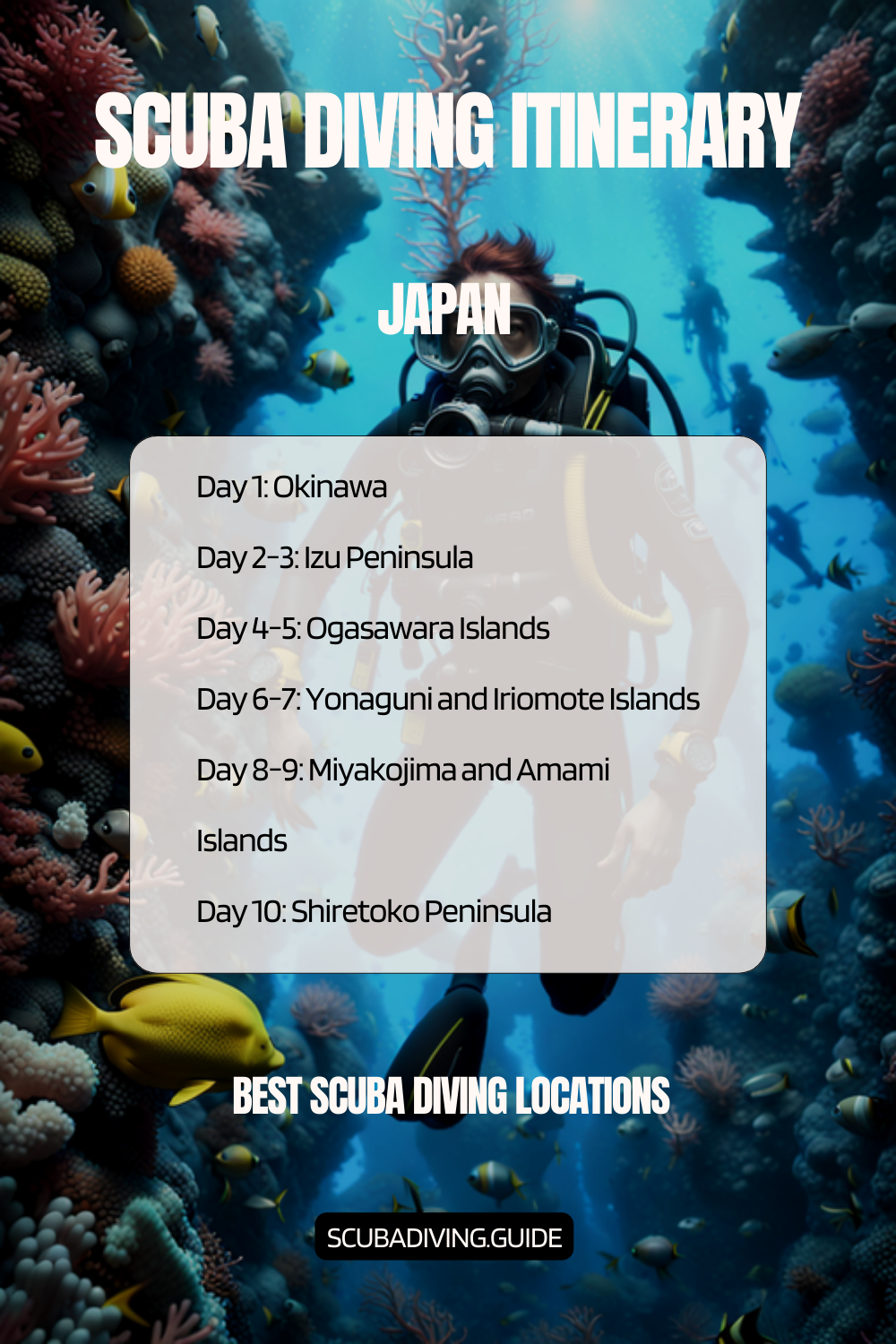
Other Countries to Consider
FAQ – Scuba Diving in Japan
What is the best time of year to go scuba diving in Japan?
The best diving time varies by region. Okinawa is great all year with warm waters. Hokkaido shines in summer (June to September). The Izu Peninsula is best from spring to autumn (April to November).
Each place has its own best season. So, the timing changes based on where you go.
Do I need a special certification to dive in Japan?
While not required, a PADI certification is recommended. Most dive shops need an open water certification or similar experience. If you’re not certified, many places offer beginner courses and dives with instructors.
What marine life can I expect to see while diving in Japan?
Japan’s waters are full of life. Okinawa has tropical fish, coral reefs, and manta rays. The Ogasawara Islands are home to unique species.
Hokkaido offers cold-water creatures like giant Pacific octopuses and diverse kelp forests.
How expensive is scuba diving in Japan?
Prices vary by location and experience. In Okinawa, dives cost ¥8,000 to ¥15,000 (about $55-$100). Costs include equipment rental, guided tours, and packages.
Remember to budget for travel, accommodation, and courses too.
Is Japanese language skills necessary for diving?
Knowing some Japanese can be helpful. But, many dive shops in tourist spots like Okinawa and the Izu Peninsula have English-speaking staff. Learning diving-related Japanese terms can also improve your experience.
What safety precautions should I take when diving in Japan?
Dive with a reputable PADI center, check your gear, and follow local rules. Always dive with a buddy and know the weather and currents. Dive insurance and a medical check are also wise.
Are there any unique diving experiences in Japan?
Yes! The Ogasawara Islands offer a UNESCO World Heritage dive. Miyakojima has clear waters. Hokkaido has cold-water dives, and the Noto Peninsula has unique Sea of Japan ecosystems.
Each spot offers a special underwater adventure.
What equipment should I bring for diving in Japan?
Many shops rent gear, but bring your own mask, dive computer, and camera. For Hokkaido, a dry suit is key. In Okinawa, a lightweight wetsuit is better. Always check with your dive center for specific gear advice.
